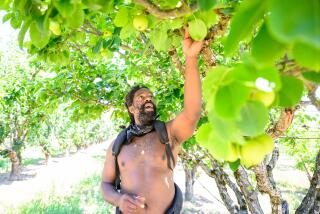Historic Farm Raises Crops as Well as Consciousness
- Share via
STROUDSBURG, Pa. — A few miles from the hubbub of the Poconos resort area is a farm where people wear the clothing of 18th-century German immigrants while performing their anachronistic chores.
They are paid to do so, and evidently have done a good job, since the nonprofit Quiet Valley Living Historical Farm is in its 38th year in a region becoming more and more crowded with new homes and chain stores.
“Kids come today that don’t know what a cow is,” said Sue Oiler, who runs the 115-acre farm with her husband, Gary. “We try to convey what is in the past, and how we got here.”
The farm began in the late 1700s under the hands and tools of a German immigrant family. Six generations of the family worked the farm before selling out to another family in 1913.
That family sold the land to Sue Oiler’s parents in 1958, and five years later they created the living historical farm. To keep it solvent, in 1974 the Oilers turned it into a nonprofit corporation and became its full-time managers.
Now it employs 25 mostly seasonal workers and runs several tours a day, six days a week, not to mention a range of craft demonstrations and special events. The nonprofit status helps attract volunteers--500 of them.
The workers, decked out in straw hats, suspenders or checkered full-length dresses, live elsewhere but seem at ease on the farm in their out-of-date clothing.
There are some compromises: The Oilers live just up a path in a modern ranch-style home, a stone’s throw from a barn built in 1850.
The pigs, horses, cows, goats, sheep, chickens, geese, guinea fowl, rabbits and Gus, the retired mule, remain in the barn or on the surrounding acres of grazing fields.
Inside the large, fenced-in garden, a number of crops grow, including lettuce, beans and flax, which the workers process and weave into rope.
But the work doesn’t end there. The Oilers and the workers churn butter, smoke meats, dehydrate corn and beans, harvest and split wood, shear and spin wool, cut and flail grain, bake bread on a brick hearth and fashion candles out of animal fat. Occasionally Gary Oiler slaughters one of the animals.
Most of the farm meat and produce goes to feed the workers and volunteers. A lucky few get to take things home, like eggs or loaves of bread baked on the brick hearth.
The draw of Quiet Valley is such that some of the volunteers have given up their careers for it.
Thirty years ago, Barbara Lord quit her art teacher’s job to volunteer full time at Quiet Valley.
Now she and her husband, Bill, spend a few days a year at the farm showing off skills they learned there. Bill, a retired mechanical engineer, is an amateur tinsmith, which he calls a disappearing art. Barbara spins and weaves wool and flax.
Visitors to Quiet Valley see workers in period costumes using period methods of farming, including real 1800s contraptions at work, such as a corn sheller or a dog treadmill that churns butter.
Structures that date to the 1800s include the family home, which features a kitchen that was remodeled in 1892, a hay barn, a smokehouse and a one-room log cabin.
Oiler tries to impress on visitors how the original farmers lived daily.
Family members worked together, midwives aided in home childbirth, and at Christmas, children received simple handmade toys, like a makeshift dart--goose feathers stuck into the end of a stripped corncob.
And Oiler tries not to shield visitors from some of the realities that may be considered gruesome now.
For instance, workers tell visitors that geese were plucked alive. When visitors enter the cellar kitchen, one of the girls will often toss them a light, papery globe. Then she tells them they just caught a “bladder ball”--that is, a dried pig’s bladder.
Even waste was useful. For instance, excess fabric was woven into towels or hats. Cornhusks were lashed together to make a floor mat. And a pig’s stomach was made into a kind of wrapper that could seal a jug to preserve food inside.
“It gives you a much different perspective on life,” Oiler said, “doesn’t it?”
More to Read
Sign up for Essential California
The most important California stories and recommendations in your inbox every morning.
You may occasionally receive promotional content from the Los Angeles Times.













